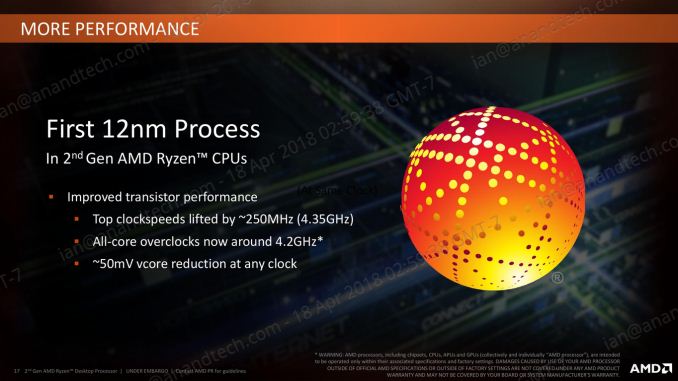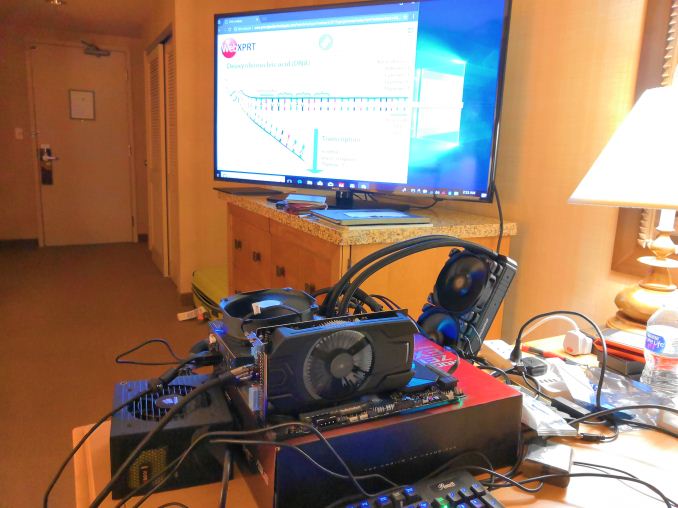The AMD Threadripper 2 Teaser: Pre-Orders Start Today, Up to 32 Cores
by Ian Cutress on August 6, 2018 9:00 AM ESTWhat Is New: Zen+ Updates
For all the new Ryzen Threadripper 2000 series, the Zen cores inside are in ‘Zen+’ mode, which affords three or four main new features, identical to the Ryzen 2000-series.
First up are the faster caches – as we saw in our Ryzen 7 2700X review, the L1 and L2 caches are slightly faster, the L3 cache gets a boost too, and the main memory support goes up from DDR4-2666 to DDR4-2933. All this accounts for a 3% IPC increase, and is the result of better understanding the design and tweaking the internal dials to extract best performance.
Second, the Zen+ cores also take advantage of GlobalFoundries' 12nm process, an enhanced version of their 14nm process used for Threadripper-1000. While not an optical shrink, it does allow AMD to extract higher frequencies as well as reduce voltage at the same time. Along with the new turbo methodology, combining this with the 3% IPC gain from the caches resulted in an overall 10% performance gain in the Ryzen 2000-series processors.
Third is Precision Boost 2, which manages how the CPU implements its turbo depending on workload. Rather than referring to a fixed turbo table, relating how many cores are active to a given frequency, PB2 now means that the internal sensors guide how much power/temperature is still available and prompts the CPU to increase frequency until it hits that barrier. Due to the 25 MHz granularity of the multiplier, this allows the processor to boost as much as possible for performance. We saw this on the Ryzen 2000-series processors and it worked really well, although it is worth noting that it does increase power consumption for variable threaded workloads.
Fourth is XFR2, or ‘eXtended Frequency Range’. This is essentially the ‘temperature’ bit of Precision Boost 2, but uses the benefits of a cooler ambient temperature and better cooling to push the processor frequency. In for the mainstream Ryzen 2000-series processors, this afforded up to a 10-15% performance increase. For today’s announcement, as this is not the embargo for performance numbers, we can’t give you hard data. However AMD included both the Wraith Ripper (a 250W-rated air cooler) and the Enermax Liqtech 240 (a 500W-rated liquid cooler) in our press kits for exactly this reason.
(A note here: we’re currently going through a heat wave in Europe, one of the biggest ever, and home air conditioning does not really exist in the UK. As a result, AMD has hit a spot of potential bad luck, as it means a lot of reviewers will be hampered by the super-high ambient (32C+) ‘home office’ temperatures. I have lucked out – Intel invited me to an event in San Francisco this week, so despite having to cart 30kg of kit 5500 miles away, I am currently testing in a thermally controlled 20C hotel room while on the road. All this being said, it would be interesting if European reviewers that are struggling in the heat this week were to re-test in a few months, when ambient temperatures are back to being reasonably cool. As for Americans, we all know you lot love your AC, especially in AMD's home state of Texas)
Sweet Memories
One of the big questions when AMD initially announced the second generation of Threadripper was around the memory configuration. In the first generation, the two active dies on the chip each used two memory channels giving a total of four. For the second generation, with four active dies, we now have a non-uniform memory design: two dies have access to two memory channels each, while the other two dies have zero memory channels directly connected, meaning that memory accesses require a hop.
To clarify, as people were speculating, the design is not one memory channel per die. While not impossible, doing it that way would require adjustment of the pin-out arrangement and Threadripper firmware. This is only designed to be a mid-generation microarchitecture refresh, not a full update. One of the benefits is that these processors should go straight in to all motherboards currently on the market without a BIOS flash, although once installed, an updated BIOS is recommended for enhanced memory and feature support.
When discussing the matter with AMD, they noted that this memory configuration means that the scheduler in the operating system will aim to fill in the cores directly attached to a memory controller first. However, it will not be a simple case of filling up 16 cores across the two directly connected dies first: after the first few threads are allocated, new threads will enter a round-robin mode, where the ‘value’ of a thread landing on a core changes based on how the other cores are loaded. If it makes sense for power and temperature reasons, threads will spawn on the silicon not directly attached to memory, for example. So it is something to note, as Threadripper 2 core scheduling isn't going to be as simple as it may initially appear.
While users were speculating on a fairer memory distribution, almost no-one touched upon the PCIe situation. As with the memory, the PCIe lanes will also only come from two of the silicon dies, rather than split between all four. Most if not all motherboards should support multiple graphics cards and other add-in devices as a result.















101 Comments
View All Comments
gipper51 - Monday, August 6, 2018 - link
It is comical the number of folks who think the only purpose for a high end PC is to play games.rocky12345 - Tuesday, August 7, 2018 - link
This is true 100% I blame a lot of it on the tech sites (not Anandtech of coarse) that try to focus on gaming with CPU's that clearly are made for more than just gaming yes they can game but CPU's like this are designed for so much more. When Anandtech's review comes out I am sure they will have the proper tests done for CPU's like this and yes they may also through in a few games just to show that these CPU's can also do a bit of gaming which is fine.edzieba - Monday, August 6, 2018 - link
"Make a list of the top 15 reasons people who actually do work and could use a high-end workstation to take care of business. Now question: will the Core i9-7980XE be faster atany single one?"I'm in the middle of a rush rollout of quad-core machines to replace several tens of thousands (workdwide, only a 'few' thousand in this building) of dual-octacore-CPU workstations because before purchase and rollout, nobody bothered to look at users' actual workloads. Turns out threaded workloads were exceptionally rare, so all the monster workstations were utterly worthless in real world performance compared to the 'low spec' machines the back office staff were using.
Pretty much any highly threaded workload has already been offloaded to a GPU (or Phi) coprocessor, or moved entirely to a remote HPC cluster. For desktop workstations, threaded workloads are the exception rather than the rule.
edzieba - Monday, August 6, 2018 - link
And this is at a Fortune 5 company, who not only should know better but were repeatedly told their purchasing decision was a terrible mistake. But it's hard to fight simple "more cores is more better!" marketing with specific-use-case benchmarking numbers, eyes start to glaze over.mapesdhs - Monday, August 6, 2018 - link
Also shows that the very people employed to provide proper advice on such things are often the first to be ignored. Been through that lunacy several times when I was a sysadmin.johnnycanadian - Monday, August 6, 2018 - link
Oh man -- I know this may sound quite unethical and downright sketch, but hopefully you, as an enthusiast, can get a few of the older machines sent your way to noodle around with ... or build your own (somewhat TDP/performance obsolete) data centre! :-)edzieba - Monday, August 6, 2018 - link
Nope, they take Data Remanence very seriously (and a good chunk of the drives pass through my hands anyway). A machine that went walking out the building without being processed through bag & tag and scanned by the disposal service would make a lot of people very upset and generally be considered a bad move.rocky12345 - Tuesday, August 7, 2018 - link
Yea they would rather have them sent to the recycle plant and destroyed most likely once the hard drives are removed of coarse. I am just guessing that they send them to the recycle plant to get destroyed maybe they send them off for donations for all I know without the hard drives..lolguyr - Tuesday, August 7, 2018 - link
edzieba: "Turns out threaded workloads were exceptionally rare, so all the monster workstations were utterly worthless in real world performance compared to the 'low spec' machines the back office staff were using."Certain industries benefit greatly. I worked in software development, and many-core workstations are a great benefit. Developers typically run the entire stack locally: database, app/web server, and client, so they can find where the problems are without affecting coworkers. Each one of those platforms is multi-threaded (or multi-process), so 40+ threads is common.
Your general point is true, and has been for decades: be aware of your runtime environment, and allocate resources which reflect those realities.
jospoortvliet - Tuesday, August 7, 2018 - link
I must say it surprised me to discover even excel and other office apps are slowly going multithreaded though... as are browsers, with Chrime earlier and now Firefox leading. If you can do even CSS and JavaScript multithreaded every normal computer user suddenly benefits. I doubt they get benefit beyond 16 threads soon but a hyperthreaded octacore is finally useful for a normal user and ibcannimagine a heavy multitasking desktop office worker keeping 16 real/32 logical cores busy. I know i have run out of space on my quad-core years ago and i hope AMD brings more than 8 cores to mainstream soon as threadripper is a tad expensive...